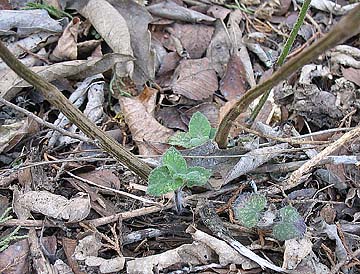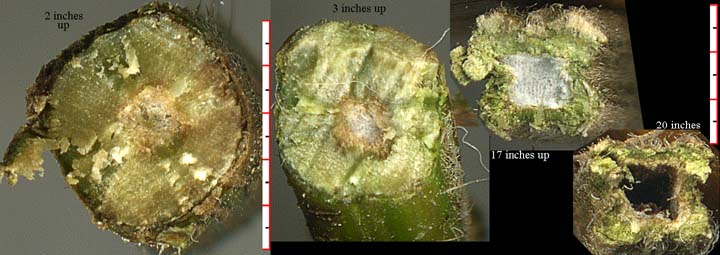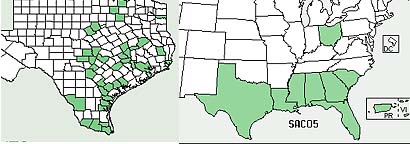
Similar to our other crystallofolia species, S. coccinea shows indications of an active winter root, having already established new leaves. The stem is still green at the base, and has probably suffered more from our local drought than from cold this winter.
Coblentz had found that the square–stemmed Cunila had an interesting anatomy:
... stem is somewhat rectangular in outline, the pith having a similar shape, but the "corners" are rotated 45°. At these "corners" of the pith there is but little wood between the pith and the bark, and it is along this line that the stem often cracks. [p. 492]My (crudely cut) cross sections taken at four points from 2 inches above the ground to c. 20 inches show that S. coccinea lacks this rotated alignment of the pith, the corners of the stem being aligned with the corners of the pith (one corner of each marked with red below).


Red lines shows the stem/pith alignment shown for one corner of each section.
Metcalfe & Chalk 1950, fig. 251, illustrate several stem types for the mint family, Lamiaceae (Labiatae), but none of these have piths that are clearly rectangular. One, Perovskia atriplicifolia (young stem), seemed to match Coblentz's pattern, but the plant anatomist I consulted said the pith was round and finding a square was 'a stretch.' Here is Metcalfe & Chalk's transverse section — colored by me: secondary xylem (with vessels) in blue; collenchyma cells at the four 'corners,' orange; pith, yellow:
Metcalfe & Chalk do note, however, (p. 1047):
Stems in many [mint] genera and species quadrangular in transverse section ..., with well-defined groups of collenchyma* in the 4 angles.Native populations of S. coccinea are not known to display crystallofolia.
*Note: Collenchyma cells are living cells that provide relatively flexible structural support to the stem. It is probably this added support at the angles, rather than the form of the pith, that makes the epidermis between the corners more susceptible to rupture.

USDA distribution maps for S. coccinea in Texas & the U .S.